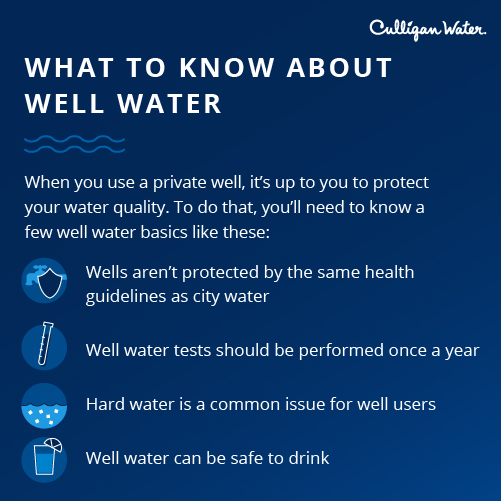The Only Guide for Well Water Testing
The Only Guide for Well Water Testing
Blog Article
8 Easy Facts About Well Water Testing Explained
Table of ContentsThe Main Principles Of Well Water Testing All about Well Water TestingExcitement About Well Water TestingThe Main Principles Of Well Water Testing

Federal government agencies do not check or control water quality secretive wells, and water screening is not needed by any kind of federal or state regulation. If you are just one of the 1. 7 million Georgians with a personal well, you are accountable for the high quality and safety of your well water.
Effectively built and kept water wells can supply years of hassle-free service. Surface area pollutants might enter the well if it is not appropriately constructed and preserved, and the well might eventually weaken or become damaged as it obtains older. On top of that, some groundwater naturally has several chemical materials at levels above the EPA's health-based criteria, called the Maximum Impurity Levels (MCLs)
Evaluate the water once yearly for complete coliform bacteria, nitrates, complete dissolved solids and p, H degrees. If you presume various other impurities, you should evaluate for those. In contrast, the top quality of water in malfunctioning wells might change unexpectedly and continue to be unnoticed as the water might look, smell and taste the exact same.
All about Well Water Testing
Minimum Screening Recommendations Well, Upkeep Yearly All geographical areas Nitrates (Overall Nitrate and Nitrate+Nitrite) Annual Annual Basic Water Chemistry (see below) plus Alkalinity, Soluble Salts (or Complete Dissolved Solids), Nitrate, Chloride, Fluoride and Sulfate Originally and afterwards every 3 years p, H, Firmness, Aluminum Calcium, Chromium, Copper, Iron, Magnesium, Manganese and Zinc Yearly after initialcomprehensive water chemistry Extra Evaluating Suggestions Verification of Possible Contamination At the very least when and then annual follow-up for:1) homes with plumbing that pre days the 1987 pipes codes with copper piping with lead solders2) extremely old houses in which there are lead pipes3) residences with brass and/or chrome fixtures (brass contains 3-8% lead; chrome components consists of lead) All geographicalregions A minimum of when and after that an annual follow-up Southern Coastal Plain region listed below the "Autumn Line" on the, Georgia map A minimum of once and afterwards a yearly follow-up Piedmont-Blue Ridge areas above the "Autumn Line" on the Georgia map Volatile and Semi-volatile Organic Compounds, Pesticides, Oil Hydrocarbons and Other Organics Not called for on a regular period; recommended just when contamination is suspected. Well Water Testing.
Examples accumulated from a kitchen area tap would mirror the source water homes plus any prospective contamination from the well owner's water supply system. Sampling at the wellhead for lead is not essential, but sampling from the tap for lead would certainly indicate if lead solder was utilized in the pipes.

The main MCLs have been evaluated focus that offer a wide margin of defense from dangerous health results for the majority of people over a life time of drinking. Also though main MCLs are enforceable standards for PWSs just, private well proprietors may pick to follow great site these criteria to shield themselves from the prospective wellness danger of drinking infected water.
The Basic Principles Of Well Water Testing
The alcohol consumption water requirement for nitrate is 10 ppm; over this degree nitrate can have adverse impacts on human health and wellness, particularly babies under the age of six months. Pesticides are substances utilized to avoid, ruin, drive away, or mitigate pests.
Cyanazine breaks down in the environment into different chemicals. Some of the break down products of cyanazine have been spotted in Minnesota water. Pesticide analysis in water samples can be costly and using particular chemicals can vary throughout the state making it challenging to understand which chemical to examine.
Based upon this, we suggest that you call the MDA before tasting your well for pesticides. The advancing or worsening wellness threat related to low degrees of numerous chemicals in alcohol consumption water is not well comprehended right now. Well Water Testing. Generally, vulnerable populations such as infants, children, and pregnant/nursing women are at biggest danger
We are presently sampling view wells for nitrate in territories with vulnerable groundwater and that have significant row plant production for nitrate as component of the Town Testing Program (TTP). Greater than 70,000 private wells proprietors will be offered nitrate screening in over 300 municipalities. House owners are offered a chemical examination via the Private Well Pesticide Tasting (PWPS) Job if nitrate is detected in their initial area testing example.
See This Report about Well Water Testing
The MDH advises using a recognized laboratory to evaluate your water. To identify a research laboratory to have your well water tested, go to Minnesota Division of Wellness (MDH) Certified Environmental Laboratories. The personalized search tab on this web page permits you to search for a laboratory that accepts examples from exclusive homeowners.
When possible, it is best to remove sources of contamination or change a polluted water supply with a safer supply of water instead of count on a home water therapy system. The cost to test for pesticides in water may exceed the cost of a point-of-use home treatment system, such as reverse osmosis for drinking water.
If you decide to install a home water treatment unit, the unit (or devices) you pick need to be certified and labeled to reduce or remove the substance you are concerned about. If there is greater than one substance you want eliminated from your water, you may need to combine several treatment procedures right into one system.
Report this page